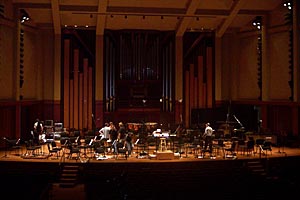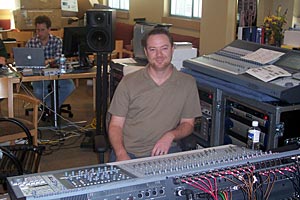Cellular / 2004 Composed
| # | Title | Duration | |
|---|---|---|---|
| 1 | Opening / Abduction | 3:13 | |
| 2 | Going Shopping | 3:35 | |
| 3 | Making a Connection | 2:20 | |
| 4 | The Bait | 3:08 | |
| 5 | Mooney's Curious | 1:22 | |
| 6 | Freeing Ricky | 4:05 | |
| 7 | School's Out | 4:23 | |
| 8 | We're Going to Die | 2:11 | |
| 9 | LAX | 4:21 | |
| 10 | Epiphany / The Bank | 4:04 | |
| 11 | The Pier | 4:10 | |
| 12 | The PierLost Connection / Dirty Cops | 4:44 | |
| 13 | Hot Porsche / Simply Biology | 3:37 | |
| 14 | Police Station | 4:01 | |
| 15 | Fake Out | 2:16 | |
| 16 | Shoot Out | 5:42 |
John's Thoughts
Once in a blue moon you get on a film that literally ends up being a journey. In the case of Cellular, an eight month trip - well, at least a trip in time. I was on very early to begin writing thematic ideas and temp the film with my synth mock-ups so that we could test the film with the actual rendering of the score - which can be a very scary thing for a composer, opening oneself up to criticism from all angles even before a note is actually recorded with a real orchestra. But the positive side is that you get everyone on board with your music and give the film a thematic continuity that a temp score can't do. The negative can be when a film ends up in post production for a long time, and your music can be something that's been hanging around awhile that they can tire of. It also can often get edited in strange ways as the picture is re-cut. So I was constantly trying to update my mock-ups as the picture changed in the editing room. Even after we recorded the score for real, there were picture changes. Thanks to the age of digital editing, we conformed the original score to the final picture pretty smoothly.
The music idea behind Cellular was to try and give this popcorn action film a slightly more sophisticated edge; to make the score modern yet timeless at the same time. It needed to be a score that pulled out the stops when it needed to, but did it with taste. The best way to set up this "taste" was to begin the film with intriguing title music that pulled in the audience into the world of the film. This is the "Cellular" theme, where I incorporated a touch tone sample from a cell phone and wrote accompanying staccato notes with flute and clarinet to give the phone sounds a texture more organic to the orchestra. This motif was then used throughout the film in various ways. The "mystery" in the theme was supplied by vibe and harp ostinatos as foreboding brass chords swell in and out. I had written the first version of this theme on it's own without picture. When I was sent the first reel, I began the theme at the Newline logo. I was tickled that it worked terrifically with the logo animation and brought us right into the titles. Logos can often be sacred territory for a studio, but to my relief everyone was on board to have the score be over the logo. This theme also comes in most effectively when Jessica is trying to manipulate the wires on the phone to get an outgoing call to someone.
The other goal of the score was to try and create an emotional link between our two main characters, Ryan and Jessica, who never actually meet until the end of the film. So for them I gave them the same theme, but morphed it to be tenderer on Jessica. It then develops throughout the score to become more heroic for Ryan. A theme for each of them would be too confusing, so I thought one that they share would make more sense. It also gave more sympathy to Jessica's character and the desperation she feels for her kidnapped son – like in the cue, "The Bait."
Lastly, in a ballsy move, I decided to incorporate the sound of police sirens within the "bad guys" theme, giving a nod to the fact that they are actually bad cops. To avoid this being too literal, I took the siren sample and played it in different ranges to bend in and out of the orchestra. I then used bending brass to compliment this motif for the bad guys. I liked the end result as a sort of sly, albeit overt, nod to their real identities. As an added creep factor, I incorporated some dulcimer and trilling violins as a layer over these motifs.
One of the cornerstones of the action cues was some aggressive French horn writing; so to insure I had the power we needed, we used eight of them, four trombones, and two or three trumpets. It was a blast to hear the brass blasting through the huge concert hall where we recorded the score in Seattle.


John without Sleep / Benroya Hall - the aftermath

Casey at work


